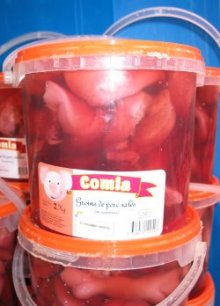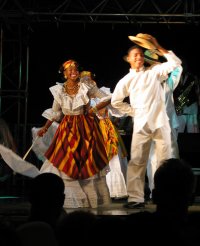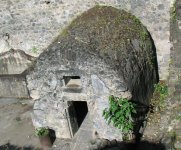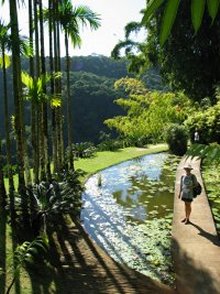 Martinique
- January 2004
Martinique
- January 2004
|
We arrived in France (because Martinique is a part of France both politically and culturally) on 15th January after an overnight sail from Barbados. Being French means that in Martinique you can experience all that's good about France, such as the food, wine and sophistication (whatever that is!). And they drive like they do in France too - nae manners, too fast, cut corners, that kind of thing.
|
|
French sophistication - what can you wipe up with Martiniquan kitchen paper?.... |
Another delight available at all good French supermarkets - Groins de porc sales - salted pig snouts! |
|
Anyway, we tied up in Marin, a big yachting centre, because we had a list of jobs to do on the boat (boats need constant attention in case you don't know). |
A local yole sailing in Marin harbour. |
|
The rear of Marin church and its cemetery. |
|
We spent about a week fixing and making things which included repairing the waterlog watermaker, getting a cracked casting on the Aries windvane welded, making a large sun awning to shade the decks, adding a new solar panel, servicing the winches, making a sun cover for the liferaft and a host of other wee jobs. But we had croissants and fresh fruit for breakfast and smelly French cheese and baguettes for lunch and the sun was shining, so we weren't suffering too much. |
|
Creole Ballet. |
We even had a night at the ballet! This was creole ballet which turned out to be a kind of mix of Afro-caribbean and old-style French dancing (in Tom's expert opinion!). It was good entertainment, especially when accompanied with "Ti Punches" - local rhum mixed with sugar and a slice of lime. "Ti" is the Creole word for "wee" - imagine going into a Scottish pub and asking for a wee punch?!... |
|
Another cultural highlight was Burns night celebrated with three other Scots - tinned haggis, tatties and some local thing that looked like neeps! Tom did "To a Mouse" and Sue did "The Man from Iron Bark" (don't look in your Burns book for that one, it was written by Banjo Patterson, the author of "Waltzing Matilda"). Alistair looks on as Margot does a cracking reading for our Burn's Night celebration! After a week of hard graft, we were ready for a holiday, so we hired a car for two days and headed out of town. The interior of Martinique is quite hilly and normally shrouded in cloud, which makes everything green and lush. There are several rhum distilleries which use the locally produced sugar cane. The climate is ideal for growing all types of tropical fruit and vegetables and we had our fair share of these! |
|
We stopped in St Pierre, previously the main town on Martinique and scene of a devastating volcanic eruption in 1902. The nearby Mont Pelee sent a hot cloud of gas and ash over the town, killing all but two of the 29,000 inhabitants. One survivor was a cobbler working in his cellar and the other was a murderer locked in a stone prison cell. |
St Pierre waterfront with Mont Pelee shrouded in cloud behind. |
|
The St Pierre cathedral bell. |
A stack of glasses, melted by the heat of the pyroclastic flow. |
The life-saving prison cell. |
|
We also visited a rhum distillery, but to be honest, when you've seen one... They still have fighting cocks in Martinique and the distillery kept several. The one below is called Bay Zepon and the label on his cage says: "Fighting cock 2 years. Combative, obstinate, passionate. I am without doubt the best cock in the island, unbeaten to this day. I am the cock of the moment." Bay Zepon, a fighting cock. Next day, we climbed Mont Pelee. You may think that we seem to have an unnatural fascination with volcanoes, but it's just that most of the oceanic islands on our route are volcanic, so it's difficult to avoid them. We also popped into the Jardin de Balata and brushed up on our latin plant names ..... aaargh! There were some hummingbird feeders there too. |
|
Balata Gardens. |
Humming bird and friend. |
|
We stayed at Martinique for a couple more days and then headed north again to the next island, Dominica. On the way, we passed Diamond rock. During the Napoleonic wars the British considered stationing a warship at the entrance to Marin harbour. Then someone had the bright idea that Diamond rock was in the ideal position for such a ship, so they landed a crew, guns and stores and made the rock HMS Diamond. The French tried but were unable to capture it for a year and a half. They finally managed it by using a trojan horse - a ship full of rum was allowed to fall into British hands and soon after the French took the rock without much fighting. |
HMS Diamond. |
|
We spent one night anchored off St Pierre followed by an easy day sail across to Dominica, the next island north. |




